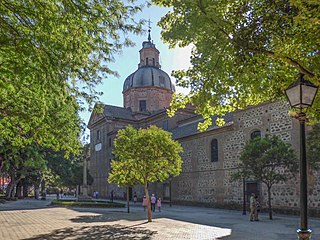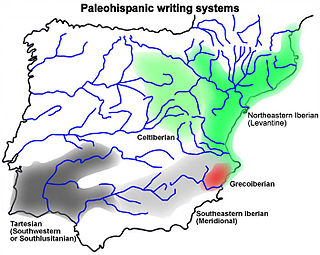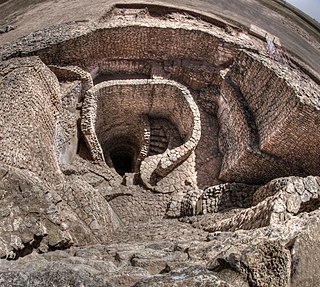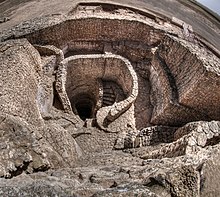
The Iberian Peninsula, also known as Iberia, is a peninsula in southwestern Europe, defining the westernmost edge of Eurasia. It is divided between Peninsular Spain and Continental Portugal, comprising most of the region, as well as a small part of Southern France, Andorra, and Gibraltar. With an area of approximately 583,254 square kilometres (225,196 sq mi), and a population of roughly 53 million, it is the second-largest European peninsula by area, after the Scandinavian Peninsula.

Castilla–La Mancha is an autonomous community of Spain. Comprising the provinces of Albacete, Ciudad Real, Cuenca, Guadalajara and Toledo, it was created in 1982. The government headquarters are in Toledo, and its largest city is Albacete.

Talavera de la Reina is a city and municipality of Spain, part of the autonomous community of Castile–La Mancha. Its population of 83,303 makes it the second most populated municipality of the province of Toledo and the fourth largest in the region.
The Castro of Vila Nova de São Pedro is a Chalcolithic archaeological site in the civil parish of Vila Nova de São Pedro, municipality of Azambuja, in the Portuguese Estremadura area of Lezíria do Tejo. It is important for the discovery of thousands of arrowheads within its fortified settlement, associated with the Chalcolithic period of human settlement. associated with the long-lived fortified town, or castro, of Zambujal, near the municipality of Torres Vedras. The period of "urban" settlement lasted from 2600 to 1300 BCE, and was a contemporary of the southeastern Spanish settlements of Los Millares and El Argar.

The Argaric culture, named from the type site El Argar near the town of Antas, in what is now the province of Almería in southeastern Spain, is an Early Bronze Age culture which flourished between c. 2200 BC and 1550 BC.

Valdepeñas is a municipality in the province of Ciudad Real, in the autonomous community of Castile-La Mancha, Spain. It is also the seat of the judicial district that covers the localities of Moral de Calatrava, Santa Cruz de Mudela, Viso del Marqués, Torrenueva, Castellar de Santiago and Almuradiel.

Villarrobledo is a Spanish city and municipality in the province of Albacete, part of the autonomous community of Castile-La Mancha. It's better known for having the world's largest area covered by vineyards as well as the world's greatest production of La Mancha wine, called in Spanish Denominación de Origen. Also, it is an important center of Manchego cheese production and export and has other important industries like metallurgy and transportation.
Daimiel is a municipality in Ciudad Real, Castile-La Mancha, Spain. It has a population of 17,342, and a mechanical industry. The football club is Daimiel CF. The Tablas de Daimiel National Park, a well-known but endangered wetland natural reserve, lies partly within the boundaries of the town.

Villarrubia de los Ojos is a municipality of Spain located in the province of Ciudad Real, Castilla–La Mancha. The municipality spans across a total area of 281.86 km2 and, as of 1 January 2020, it has a registered population of 9,762.

The 4.2-kiloyear BP aridification event was one of the most severe climatic events of the Holocene epoch. It defines the beginning of the current Meghalayan age in the Holocene epoch.

The northeastern Iberian script, also known as Levantine Iberian or Iberian, was the main means of written expression of the Iberian language, but has also been used to write Proto-Basque as seen in the Hand of Irulegi. The Iberian language is also expressed by the southeastern Iberian script and the Greco-Iberian alphabet. To understand the relationship between northeastern Iberian and southeastern Iberian scripts, one should point out that they are two different scripts with different values for the same signs. However, it is clear they have a common origin and the most accepted hypothesis is that northeastern Iberian script was derived from the southeastern Iberian script. Some researchers have concluded that it is linked to the Phoenician alphabet alone, but others believe the Greek alphabet also had a role.
Richard John Harrison is an archaeologist and Professor in the University of Bristol, England. Harrison studied at Selwyn College, Cambridge, and gained his Bachelor's degree in Archaeology and Anthropology from the University of Cambridge in 1970. He held a Prize Fellowship at Harvard from 1970 to 1975, and was awarded his PhD in Anthropology from Harvard University in 1975. His first employment was in the Department of Prehistoric and Roman-British Antiquities at the British Museum, from where he moved to the University of Bristol as a lecturer in 1976. In 1977 he was elected a Fellow of the Society of Antiquaries of London, and in 2003 to be a Corresponding Fellow of the Deutsches Archaeologisches Institut in Frankfurt, Germany.
This section of the timeline of Iberian history concerns events from before the Carthaginian conquests.

Puntal dels Llops is a small Iberian hilltop fort, located near the modern town of Olocau, in Valencia province. It overlies an earlier Bronze Age site. Its original name in Iberian is unknown. It was built in the late fifth or early fourth century BC and destroyed violently around the end of the Second Punic War or in the early second century BC. The site is part of a network of fortified sites that surround the large Iberian town of Edeta and so is important to understanding the formation and organisation of Iberian polities. The archaeological site may currently be visited.

The Lloma de Betxí is a Bronze Age archaeological site in the municipality of Paterna (Valencian Community. It is on the top of a hill at 99m over the sea level and 30m over the surroundings. It is in the county of Paterna, nearby the Turia river, close to Valencia city. The chronology of the site: 1800 – 1300 B.C., part of the Valencian Bronze Age.
The archaeological site of Les Raboses is located on the mountain with the same name in the municipality of Albalat dels Tarongers. This deposit is framed chronologically in the Bronze Age.

Helena Bonet Rosado is a Spanish archaeologist who specialises in Iberian material culture. She has published two books and numerous articles and chapters on Iberian archaeology. She is currently the Director of the Prehistory Museum of Valencia.

El Argar is an Early Bronze Age culture developed in the southeastern end of the Iberian Peninsula. It is believed to have been active from about 2200 B.C. to 1500 B.C. The people developed sophisticated pottery and ceramic techniques that they traded with other Mediterranean tribes.

The Cerro del Bu is an archaeological site in the Bu hill of the Spanish municipality of Toledo, located on a promontory next to the Tagus river.

The Motilla del Azuer is a prehistoric fortification dating from the Bronze Age in the municipality of Daimiel, in the Province of Ciudad Real, Castilla–La Mancha, Spain.


















